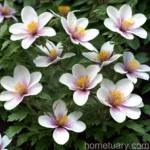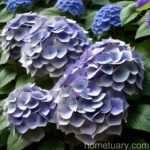The Bigleaf Hydrangea (Hydrangea macrophylla (group))
Introduction to the Bigleaf Hydrangea
The Bigleaf Hydrangea, scientifically known as Hydrangea macrophylla, is a popular ornamental plant belonging to the family Hydrangeaceae. This species is commonly referred to as the “bigleaf hydrangea” due to the size of its broad leaves. It is native to Japan, China, and Korea and is renowned for its large and showy flower heads, which can range in color from pink and blue to purple depending on the soil pH.
The Bigleaf Hydrangea is widely cultivated for its stunning blooms and is a favorite among gardeners for its versatility in landscaping and gardening. This blog post will provide a comprehensive guide to the culture, uses, care, and maintenance of the Bigleaf Hydrangea, with a focus on addressing the various aspects of cultivation and management.
Key Takeaways – Bigleaf Hydrangea (Hydrangea macrophylla (group))
Culture
The culture of the Bigleaf Hydrangea encompasses its environmental requirements, growth habits, and overall care. Understanding the cultural aspects is essential for successfully cultivating this plant.
- Sunlight: The Bigleaf Hydrangea thrives in partial shade or dappled sunlight. It benefits from morning sun and afternoon shade, especially in regions with hot summers.
- Water: Adequate and consistent moisture is crucial for the Bigleaf Hydrangea, particularly during the growing season. The soil should be kept evenly moist, but avoid waterlogged conditions.
- Soil: Well-drained, fertile, and slightly acidic soil with a pH range of 5.2 to 6.5 is ideal for the Bigleaf Hydrangea. It is important to ensure good soil structure and organic matter content.
- Fertilizer: Regular feeding with a balanced, slow-release fertilizer formulated for acid-loving plants can promote healthy growth and prolific blooming.
- Pruning: Proper pruning techniques are essential for maintaining the shape, size, and flowering of the Bigleaf Hydrangea.
- Propagation: The Bigleaf Hydrangea can be propagated through various methods, including stem cuttings, layering, and division.
Uses
The Bigleaf Hydrangea serves multiple uses in landscaping and horticulture, making it a valuable addition to gardens and outdoor spaces.
- Landscape Design: It is commonly used as a focal point in landscape designs, borders, and as a hedge or privacy screen.
- Container Gardening: The Bigleaf Hydrangea can be grown in containers, adding a vibrant splash of color to patios, balconies, and other outdoor areas.
- Cut Flowers: The large, showy blooms make excellent cut flowers for floral arrangements and indoor decor.
Popularity
The Bigleaf Hydrangea’s popularity stems from its striking blooms, adaptability to various settings, and its ability to thrive in different climates and growing conditions. The plant’s versatility, coupled with its aesthetic appeal, has made it a sought-after choice for gardeners and landscapers.
Common Diseases and Pests
Common Diseases
The Bigleaf Hydrangea is susceptible to certain diseases, and understanding their diagnosis and management is crucial for maintaining plant health.
- Powdery Mildew (Erysiphe polygoni): This fungal disease appears as a white, powdery coating on the leaves and can affect plant vigor and flowering.
- Gray Mold (Botrytis cinerea): Gray mold can cause flower buds to rot and lead to a decline in overall plant health.
- Leaf Spot (Cercospora hydrangeae): Leaf spot diseases manifest as circular spots on the leaves, often leading to premature defoliation.
Disease Diagnosis
Diagnosing diseases in the Bigleaf Hydrangea involves careful observation and proactive management to prevent their spread and minimize damage.
- Symptom Recognition: Recognizing the visual symptoms of common diseases, such as characteristic leaf spots and fungal growth, assists in early detection.
- Cultural Practices: Implementing good cultural practices, such as proper watering, avoiding overhead irrigation, and maintaining adequate air circulation, can help reduce disease incidence.
Common Pests
Certain pests can pose a threat to the Bigleaf Hydrangea, and understanding their identification and control is essential for preserving plant vitality.
- Aphids (Aphidoidea): Aphids can congregate on new growth and flower buds, causing distortion and stunting.
- Scale Insects (Superfamily Coccoidea): Scale insects can infest the stems and leaves, leading to weakened plant vigor and reduced flowering.
- Spider Mites (Tetranychidae): Spider mites can cause stippling and webbing on the leaves, impacting the overall appearance of the plant.
Botanist’s Tips
Pruning
Proper pruning is essential for shaping the Bigleaf Hydrangea and promoting robust flowering. Here are some key tips for effective pruning:
- Timing: Prune the plant immediately after flowering, as it blooms on old wood. Delayed pruning can result in the removal of potential flowering buds.
- Deadheading: Removing spent blooms can encourage the development of new flower buds and prolong the blooming period.
- Selective Removal: Thin out crowded or weak stems to improve air circulation and overall plant vigor.
Fun Facts
- The flower color of the Bigleaf Hydrangea can be influenced by soil pH, with acidic soil resulting in blue flowers and alkaline soil leading to pink blooms.
- Bigleaf Hydrangeas are utilized in traditional medicine in some cultures for their purported medicinal properties.
Links to External Resources
To expand your knowledge and understanding of the Bigleaf Hydrangea, explore the following resources:
- American Horticultural Society
- The Royal Horticultural Society
- University Extension Services
- Plant Database – Missouri Botanical Garden
Conclusion
The Bigleaf Hydrangea (Hydrangea macrophylla) is a captivating plant with immense horticultural appeal, offering a spectrum of colorful blooms and enriching landscapes with its ornamental charm. By understanding its cultural requirements, disease and pest management, and leveraging its versatile uses, gardeners and enthusiasts can foster the growth and splendor of this beloved flowering shrub.
Embracing the nuances of care and cultivation, the Bigleaf Hydrangea rewards with an enduring display of floral elegance and botanical fascination, making it a cherished addition to gardens and outdoor spaces across the world. Whether in containers, garden beds, or floral arrangements, its enduring allure continues to captivate and inspire, cementing its status as a perennial favorite in the realm of ornamental horticulture.
Keywords: Hydrangea macrophylla, Bigleaf Hydrangea, Bigleaf Hydrangea care, Hydrangea macrophylla group, Hydrangea macrophylla varieties, Hydrangea macrophylla pruning, Hydrangea macrophylla blooms, Bigleaf Hydrangea flowers, Best soil for Hydrangea macrophylla, Hydrangea macrophylla planting, Hydrangea macrophylla fertilizing, Hydrangea macrophylla watering, Hydrangea macrophylla diseases, Hydrangea macrophylla pests, Tips for growing Hydrangea macrophylla, Hydrangea macrophylla care guide, Hydrangea macrophylla landscape design, Hydrangea macrophylla season, Hydrangea macrophylla color changing, Hydrangea macrophylla pruning techniques, Hydrangea macrophylla container gardening, Hydrangea macrophylla autumn care, Hydrangea macrophylla shade tolerance, Hydrangea macrophylla sun exposure, Hydrangea macrophylla companion plants, Hydrangea macrophylla winter protection, Different types of Hydrangea macrophylla, Hydrangea macrophylla flower arrangements, Hydrangea macrophylla landscaping ideas, Hydrangea macrophylla bloom time, Hydrangea macrophylla pruning schedule, Hydrangea macrophylla soil pH, Hydrangea macrophylla butterfly attracting, Hydrangea macrophylla drought tolerance, Hydrangea macrophylla wildlife-friendly, Hydrangea macrophylla mulching techniques, Hydrangea macrophylla growth habits, Hydrangea macrophylla propagation methods, Benefits of Hydrangea macrophylla in gardens, Hydrangea macrophylla humidity requirements, Hydrangea macrophylla pollinator-friendly, Hydrangea macrophylla soil drainage needs, Hydrangea macrophylla container care, Hydrangea macrophylla pruning mistakes to avoid, Steps for successful Hydrangea macrophylla planting, Hydrangea macrophylla sun and shade balance, Hydrangea macrophylla attracting bees and butterflies, Hydrangea macrophylla seasonal color variations, Hydrangea macrophylla evergreen or deciduous, Hydrangea macrophylla cold hardiness levels















